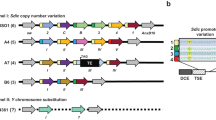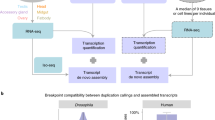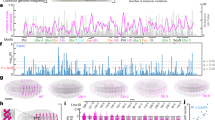Abstract
Using microarray gene expression data from several Drosophila species and strains, we show that duplicated genes, compared with single-copy genes, significantly increase gene expression diversity during development. We show further that duplicate genes tend to cause expression divergences between Drosophila species (or strains) to evolve faster than do single-copy genes. This conclusion is also supported by data from different yeast strains.
Similar content being viewed by others
Main
Different copies of duplicate genes can become specialized at different developmental stages (e.g., different copies of Hox genes1,2). Therefore, duplicate genes should have more diversified expression profiles than single-copy genes during the development of an individual. Moreover, the redundancy conferred by duplicate genes for the regulation of a function may facilitate organismal adaptation to environmental changes, so that the expression patterns of duplicate genes are, in general, expected to diverge between species faster than those of single-copy genes. The latter hypothesis is particularly interesting because changes in gene expression may lead to important phenotypic evolution3,4. A direct examination of these two hypotheses at the genomic level, however, was not possible until high-throughput gene expression data became available. In this study, we tested the two predictions using microarray data from fruit flies and yeast.
We first used the data on gene expression during the start of metamorphosis (between the late third-instar larval and white prepupal stages) in three species of the D. melanogaster subgroup. This data set included 11,723 genes from a study investigating the evolution of gene expression in four inbred strains of D. melanogaster (Canton S, Oregon R, Samarkand and Netherlands2), one inbred strain of D. simulans and one inbred strain of D. yakuba5; we compared larvae and prepupae eight times for each lineage to obtain more accurate estimates of gene expression (Supplementary Methods online). We estimated developmental changes in expression of each gene in each lineage separately using an ANOVA model5. We used the 95% confidence intervals to determine first whether a gene was differentially expressed across the start of metamorphosis in a particular lineage, and second, whether the developmental change differed between lineages (that is, whether it had evolved; see ref. 5 for methodology). These lists of genes whose expression changed during development or differed between lineages were the starting point of this study.
We conducted two analyses. First, we examined whether expression levels of duplicate genes changed significantly across the start of metamorphosis more often than those of single-copy genes (a within-genome comparison). We used strict criteria to define duplicate and single-copy genes (Supplementary Methods online; relaxation of the criteria led to the same conclusions). Furthermore, to avoid cross-hybridization, we included in the analysis only those duplicate genes that had KS values (number of substitutions per synonymous site) to their closest paralogs of >0.5 (Supplementary Methods online; all the following results were the same without this restriction). Because each gene family originated from one common ancestor, we regarded each gene family as a uniquely represented entry in our first analysis6. For this purpose, we grouped duplicate genes into families (see Supplementary Fig. 1 online for the family size distribution). We identified 3,332 duplicate genes belonging to 932 gene families in the data set. In 818 gene families, one or more family members had significant changes in expression across the start of metamorphosis in at least one strain (Table 1). The proportion of gene families that showed changes in gene expression was significantly higher (818 of 932; 88%) than that for single-copy genes (2,030 of 3,356; 60%). We obtained similar results in individual strains (Supplementary Table 1 online). Considering each duplicate gene individually, the proportion of duplicate genes (72%, 2,389 genes) that showed changes in expression across the start of metamorphosis was still much higher than that of single-copy genes (60%; Table 1 and Supplementary Table 2 online).
These observations suggest that duplication of a developmentally regulated gene is more likely to be advantageous than duplication of a gene that is not involved in development. One possible reason for this is that gene duplication can provide regulatory diversity to an organism during development7. To determine whether this is the case, we investigated differences in gene expression patterns in each gene family. Of the 818 gene families that include genes with developmental changes in expression, we found that about 70% (545) had different expression profiles (increase, no expression change or decrease) between individual genes in each family. The actual proportion might be higher, because we excluded some members of certain gene families from the expression data set. These results indicate that duplicate genes significantly increase the gene expression diversity of an organism. This conclusion is strengthened by the fact that probable differences in spatial expression patterns between different tissues were not taken into account in the above analysis.
Second, we made a between-genome comparison by examining differences in gene expression between species and between different strains within species. Of the 3,332 duplicate genes in the data set, 1,593 of them (∼50%) had significantly different expression patterns between at least two of the six strains during the start of metamorphosis. This proportion is much higher than that of single-copy genes (1,202 of 3,356; 36%; Table 2). Individual pair-wise comparisons between strains also supported this conclusion (data not shown).
We also examined differences in expression of duplicated genes between two yeast strains and observed a similar pattern. A study dissecting transcriptional regulation in the budding yeast8 compared gene expression profiles between a laboratory strain (BY) and a wild strain (RM) of Saccharomyces cerevisiae. Differential expression between strains was detected for more than 1,500 genes (of 6,215 genes; Supplementary Methods online). Using these data, we found that a significantly higher proportion of duplicate genes than of single-copy genes had expression patterns that differed between the two strains of yeast (Table 2). Therefore, the results from both fruit flies and yeast indicate that duplicate genes cause expression divergences to evolve between species (or strains) faster than single-copy genes. This conclusion also holds true for very old duplicate genes (Supplementary Table 3 online).
In both within-genome and between-genome comparisons, we found that duplicate genes were more likely than single-copy genes to show changes in expression profiles. These conclusions did not change when we used different criteria to define duplicate genes and single-copy genes (Supplementary Table 4 online). Furthermore, we found that protein function, codon usage bias or gene evolutionary rate could not explain the observed patterns (data not shown). The observed association between gene duplication and increased gene expression diversity within and between species is important for two reasons. First, divergence in expression between duplicate genes may lead to functional specialization, which is a means of retaining both copies of duplicate genes in a genome9,10. Second, we found that relatively old duplicate gene pairs still contributed to expression diversity between strains, and earlier studies showed that functional redundancy may exist between distantly related duplicate genes11,12. Thus, during speciation or adaptation, these functionally redundant copies could have more chances (less constraint) to adapt to new environmental and physiological conditions than single-copy genes. The results of this study are particularly interesting in light of the proposal that changes in gene expression can lead to important phenotypic changes in evolution13,14,15, which might lead to species differentiation. As more intra- and inter-species gene expression data become available at the genome level, the relationships among gene duplication, gene expression evolution and phenotypic change will be better understood.
Note: Supplementary information is available on the Nature Genetics website.
References
McGinnis, W. & Krumlauf, R. Cell 68, 283–302 (1992).
Jozefowicz, C., McClintock, J. & Prince, V. J. Struct. Funct. Genomics 3, 185–194 (2003).
King, M.C. & Wilson, A.C. Science 188, 107–116 (1975).
Levine, M. & Tjian, R. Nature 424, 147–151 (2003).
Rifkin, S.A., Kim, J. & White, K.P. Nat. Genet. 33, 138–144 (2003).
Rubin, G.M. et al. Science 287, 2204–2215 (2000).
Cooke J., Nowak, M.A., Boerlijst, M. & Maynard-Smith, J. Trends Genet. 13, 360–364 (1997).
Brem, R.B., Yvert, G., Clinton, R. & Kruglyak, L. Science 296, 752–755 (2002).
Ohno, S. Evolution by Gene Duplication (Springer, Berlin, 1970).
Force, A. et al. Genetics 151, 1531–1545 (1999).
Tautz, D. BioEssays 14, 263–266 (1992).
Gu, Z. et al. Nature 421, 63–66 (2003).
Wray, G.A. et al. Mol. Biol. Evol. 20, 1377–1419 (2003).
Carroll, S.B. Cell 101, 577–580 (2000).
Davidson, E.H. Genomic Regulatory Systems: Development and Evolution (Academic, San Diego, California, 2001).
Acknowledgements
We thank L. Zhang, C.-I. Wu, L.M. Steinmetz, M.H. Kohn, H. Wang, S. Hua and K. Thornton for discussions and comments. This work was supported by grants from the US National Institutes of Health to W.-H.L. and K.P.W.
Author information
Authors and Affiliations
Corresponding author
Ethics declarations
Competing interests
The authors declare no competing financial interests.
Rights and permissions
About this article
Cite this article
Gu, Z., Rifkin, S., White, K. et al. Duplicate genes increase gene expression diversity within and between species. Nat Genet 36, 577–579 (2004). https://doi.org/10.1038/ng1355
Received:
Accepted:
Published:
Issue Date:
DOI: https://doi.org/10.1038/ng1355
This article is cited by
-
Early effects of gene duplication on the robustness and phenotypic variability of gene regulatory networks
BMC Bioinformatics (2022)
-
Identification and characterization of eight metallothionein genes involved in heavy metal tolerance from the ectomycorrhizal fungus Laccaria bicolor
Environmental Science and Pollution Research (2022)
-
Population transcriptomic sequencing reveals allopatric divergence and local adaptation in Pseudotaxus chienii (Taxaceae)
BMC Genomics (2021)
-
Pheromone Gene Diversification and the Evolution of Courtship Glands in Plethodontid Salamanders
Journal of Molecular Evolution (2021)
-
Different divergence events for three pairs of PEBPs in Gossypium as implied by evolutionary analysis
Genes & Genomics (2019)



